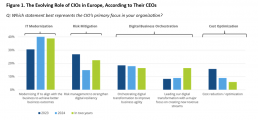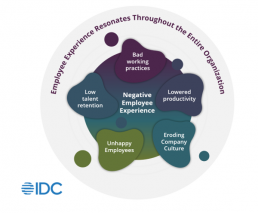Leveraging AI to Succeed in a Highly Competitive Communications and Collaboration Market
Often, I hear that the business communications market will witness more consolidation because it’s overcrowded, meaning some vendors will either exit by divesting their operations or merge with another. There is some weight to this speculation, but by leveraging AI, vendors can reinforce their positions in the market.
When I say “leveraging AI,” I don’t mean just adding new features, but also overcoming some of the hurdles that are holding back end-user adoption. To make their AI strategies a success, it is necessary for vendors to understand and address these challenges.
Key Challenges for Businesses Trying to Gain the Full Value of AI
Data silos are inhibiting AI’s full potential.
Our data reveals that businesses are at different stages of their AI journey, and the majority are still exploring, trying to determine use cases and how to extract value. Actual adoption will be determined by AI efficacy, which depends on backend data and AI training.
One challenge that limits the full value of AI is data being locked in disparate sources. Businesses often use separate systems for customer databases and CRM and utilize multiple communication and collaboration channels, creating data silos that hinder AI’s comprehensive system view.
Furthermore, these systems have different deployments, some on-premises and others in the cloud, making silos even harder to overcome.
Aggregating the different data sources, cleaning and structuring data, and training AI are the first steps in developing AI efficacy. Businesses need a connected IT stack, but this begs questions such as: Should solutions come from a single vendor who can provide a unified system in a common environment or a provider who is able to integrate different systems into a unified stream of data flow?
Many businesses are not able to adopt a unified solution from a single provider, because their investments are locked into existing IT systems and workflows. Even if systems are at the end of life, migration may not be an option due to the deep integration of workflows and strong relationships which the businesses may share with their existing providers.
Our data shows that businesses have concerns about migrating to new systems. Among other things, they are uncertain about the ultimate ROI the new system will deliver.
Data privacy is a concern.
How much data should be exposed to AI is an issue for end-user organizations as well as government regulatory agencies.
Among the many benefits of data integration is the enablement of AI to drive personalized and targeted service in customer support, as AI can view and summarize customer information from different systems. This can range from listing a customer’s name and intent on agents’ desktops to providing buying history to support agents’ upsell efforts based on customers’ past preferences.
There is, however, a fine line between personalized service and violating a customer’s privacy. While some elements of personalization can feel special and help to create a sense of emotional connectedness, it’s important not to pass the point where knowledge about the customer creates a sense of invasion.
Another concern is the need to move operations to the cloud, as most AI is cloud based. Some businesses may be unable to do this due to regulatory compliance requirements for customer databases to remain on premises. For example, healthcare providers must keep patient data on premises to maintain security and privacy .
Additionally, some businesses are concerned about losing control and visibility of their IT infrastructure and customer databases by moving them to the cloud. Data sovereignty is also a factor, as some governments (including those in Europe) require businesses to keep data within the country, forcing AI solution providers to base their solutions in local datacenters.
Strategies to Overcome Challenges Impeding AI Adoption
Base AI capabilities on integration and training, but also customer privacy and data governance.
Efficacy is critical for driving end-user adoption. This involves connecting different data sources and enabling closer and more far-reaching integrations within the ecosystem.
To this end, the market is witnessing a shift from SaaS-based to platform-based solutions, which allow integrations across different systems and third-party providers. Vendors also need to ensure compatibility with different IT environments, including integrating on-premises with cloud environments to enable business in different stages of their DX journey to access AI benefits.
The next step should be cleaning and structuring data, which can be overwhelming for businesses with particularly large/extensive data pools. This could present a business opportunity for professional service providers and systems integrators.
AI innovations should also incorporate guardrails to prevent misinformation, since AI is only as good as the data behind it and the training it receives. There should always be an option for human intervention to monitor and rectify AI-based results. Customers should be able to opt for how much of their information they want to be exposed to AI and other parties.
AI should be available for businesses who are mandated to run their operations on premises. And communications and collaboration solution providers should develop partnerships with other service providers that have widely distributed or local datacenters, thus making it possible to base their solutions in datacenters stipulated by data sovereignty requirements.
Handhold customers during the process.
Developing suitable solutions is just one part of the story. It is also necessary to educate customers who are still familiarizing themselves with AI. Our data reveals that many businesses are unsure about use cases and how AI will fit into their overall operations. It is therefore necessary to drive conversations with relevant business leaders.
IDC data shows that while IT is still an integral part of sales discussions, business leaders are becoming more involved. Deploying AI is not just about new technology but changing business culture around it involving managers, and employees at all levels.
Making AI successful within organizations requires hand-holding through the process, from education to implementation and change management.
Pay close attention to pricing.
Pricing is another important consideration, and pricing trends are wide ranging. Some vendors include AI features in their solutions without charging extra, while others offer them as add-ons at an additional price.
Not surprisingly, customers’ willingness to pay for AI solutions varies, depending on their perceived value versus price. While the unique and sophisticated functions AI can perform will influence pricing strategies, common features like meeting summarization and message composition are likely to face commoditization.
A federated approach to AI is helping to keep costs down and make it possible to offer AI as part of overall communication solution bundles. In the long run, it is likely that basic GenAI-based features will be part of overall communications solution bundles.
Work closely with partners for go-to-market motions.
Go-to-market strategies are also crucial, particularly in Europe, where much of the IT communication stack is sold through partners, some of whom need training to communicate effectively with relevant business stakeholders. Channel partners should be incentivized for go-to-market initiatives, including monetary incentives and ownership of commercial relationships.
Vendors need to provide high-touch support during the sales process but leave ownership to channel partners post-sale. Market dynamics require vendors and partners to work hand-in-hand.
Conclusion
Succeeding in the business communications market involves more than introducing new AI features. It requires ensuring data efficacy by connecting different data sources, effectively training AI, and implementing guardrails to prevent misinformation.
Vendors need to understand where businesses are in their AI journey and customize solutions to meet their needs, including integration with unique IT environments and compliance with data governance and security requirements. Educating businesses about AI benefits and helping them implement AI in a compatible IT environment is essential.
The partner community plays a crucial role in the go-to-market process, and success will necessitate close collaboration between vendors and partners.
The Dynamic Role of the EMEA CIO: Steering the Digital Ship
In the digital business and AI-everywhere era, technology is now a strategic enabler that permeates every aspect of business operations. According to IDC’s Worldwide CEO Survey (February 2024, n = 67), 48% of CEOs in Europe, the Middle East, and Africa (EMEA) now report regularly to the board on the status of digital initiatives, highlighting the strategic nature of digital technologies among businesses.
In this context, the chief information officer (CIO) is assuming a pivotal role as business leader, with digital technologies driving innovation, growth, and competitive advantage. Increasingly, the main KPIs on which CIOs are now measured are business-related metrics, from revenue growth to improving customer and employee experience, in a close relationship with other functional business leaders.
Historically, the CIO was primarily responsible for managing the IT infrastructure, ensuring its reliability, security, and efficiency. However, in today’s digital business era, European CEOs are assigning their CIOs multiple responsibilities, each one building upon the other to an increasing level of complexity:
- IT Modernization: This will be the primary responsibility for CIOs for the next two years, with the aim of making IT systems and solutions up to date and capable of providing the necessary speed, efficiency, and flexibility to improve business results. The expansion of artificial intelligence and generative AI — and the drive to generate value from these technologies — is drawing attention to the fundamental aspects of foundational IT. Modernizing IT systems and processes also requires significant organizational change, addressing concerns and resistance from stakeholders and ensuring a smooth transition to new systems and technologies. This involves training and support for employees to help them adapt to new ways of working, which requires collaboration from other C-suite roles.
- Digital Business Orchestration: In the next two years, as organizations mature into digital businesses, CIOs will be increasingly expected to orchestrate digital business initiatives across different functions, with a view to generating new revenue streams from digital business models, such as ecommerce or servitization. While C-Suite buy-in and stakeholder management are key for this progress, they will be even more essential for IT modernization. For instance, in the majority of organizations, investment decisions around artificial intelligence entail joint accountability. IDC predicts that in 2024, as part of a responsible Al strategy, 40% of CIOs in EMEA organizations adopting Al will team up with line-of-business CxOs to ensure a clear ROI on prioritized use cases (IDC EMEA Futurescape, 2024).
- Risk Mitigation and Management: Macro-shocks such as the Covid-19 pandemic, geopolitical and economic uncertainties, and supply chain disruptions have underlined the need for digital technologies to strengthen overall organizational resiliency. CIOs are tasked with ensuring business continuity and defining disaster recovery plans in the face of risks ranging from cyber attacks to unpredictable external events. Investing in security technologies to improve organizational risk posture is first priority for European CEOs and CIOs. Moreover, attention to regulatory compliance and corporate trust is on the rise, as reflected in the European Union, for example, with directives such as the Corporate Sustainability Reporting Directive (CSRD). Technology can play a key role in such areas as integrating and automating environmental, social, and governance (ESG) compliance reporting. This is why IDC also predicts that, by 2025, CIOs in at least 60% of large EMEA organizations will have components of their compensation package tied to ESG targets.
- Cost Optimization: Despite persisting macroeconomic uncertainties, European CEOs do not expect to reduce IT budgets, as digital investments are key to driving business growth. In fact, according to IDC Worldwide Black Book Live Edition (March 2023), IT spending in EMEA will grow four times faster than GDP in 2024. However, with the number of digital initiatives increasing steadily and IT modernization efforts requiring significant financial investments, CIOs are in charge of resource allocation and are often being accountable for cost control when orchestrating digital business initiatives across functions.
As the role of CIOs expands to encompass broader strategic responsibilities, these leaders are increasingly claiming their seat on the Board as digital business leaders.
To learn more about IDC EMEA CIO Predictions, download our ebook IDC FutureScape “What If You Could See Around the Corner — EMEA Perspective” or reach out to discover more on IDC EMEA C-Suite Tech Research.
The Cybersecurity Vendor’s Road Map to Success in Europe: Beyond Best Practices
The European cybersecurity landscape is evolving at an unprecedented pace, driven by an increase in cyberthreats, stricter data privacy and GDPR compliance, and the widespread adoption of cloud technologies.
For security vendors, this dynamic environment presents a unique set of challenges and opportunities. A well-defined cybersecurity strategy tailored to the specific needs of European businesses is crucial for success.
Cloud Security: Compliance and Differentiation
As cloud adoption continues to rise, so too does the need for robust cloud security measures. A strong cloud security positioning, aligned with emerging EU regulations, is essential for building trust and credibility with European customers. Vendors should equip their sales teams with buyer intelligence that highlights the strengths of their offerings and demonstrates how their solutions address industry-specific cybersecurity challenges.
Endpoint Security: Tailored Messaging for Maximum Impact
With the increase in remote work, endpoint security has become a top priority for businesses across industries. To resonate with potential customers, security vendors should develop targeted content addressing unique endpoint security concerns in sectors such as healthcare and finance. Training sales teams to effectively address objections related to the complexity and cost of managing endpoint solutions is key to success.
Managed Security Services (MSS): Catering to Diverse Needs
MSS are increasingly in demand as organizations struggle to keep up with the ever-changing threat landscape. To effectively serve the European market, vendors should define a diverse MSS portfolio that caters to both midmarket companies and large enterprises and that addresses their varying resource constraints and needs. Highlighting successful MSS implementations across different European countries, with a focus on compliance and operational benefits, can be a powerful way to demonstrate value and build trust.
IT/OT Convergence: Bridging the Gap
The convergence of IT and operational technology (OT) presents a unique challenge in the cybersecurity landscape. Industrial sectors face unique challenges, and vendors should develop clear road maps to address the integration of IT and OT security. Sales enablement should focus on equipping teams with the knowledge and tools to articulate the value proposition of converged security solutions to IT, OT, and business decision-makers.
Network Security: Staying Ahead of Emerging Threats
As network infrastructure becomes more complex and interconnected, so do the threats targeting it. Security vendors can establish thought leadership by creating content that highlights emerging network security threats, such as 5G vulnerabilities and IoT attacks.
Demonstrating how their solutions effectively mitigate these threats can be a powerful way for vendors to differentiate in a crowded market. Equipping sales teams with ROI calculators can help showcase the cost savings associated with proactive network security measures.
Data Security and Privacy: Adapting to a Changing Landscape
The evolving privacy landscape in Europe, with its focus on data sovereignty and cross-border data transfers, requires a proactive approach to data security. Vendors should align their solutions with the latest European cybersecurity standards and educate prospects on best practices and the legal implications of noncompliance. Webinars, white papers, and other educational content can help build awareness and drive demand for data security solutions.
Conclusion
By following these best practices and leveraging market intelligence, security vendors can effectively navigate the complexities of the European cybersecurity market and achieve long-term success. Building a robust cybersecurity strategy that addresses GDPR compliance, industry-specific challenges, and emerging threats will position vendors as trusted partners in the eyes of European businesses.
Interested in a deeper understanding of the issues discussed here? Contact Dominique Bindels at dbindels@idc.com.
Also, you might be interested in the following complimentary IDC guides:
Increase Customer Lifetime: The B2B Growth Marketing Guide for Tech Vendors
B2B Marketing & Sales Guide to Outcome-Focused Conversations
Don’t miss our webinar “The New Cyber Security Opportunity in an ‘AI Everywhere’ World”
The Domino Effect of Poor Employee Experience on Organizational Health: 5 Practices to Avoid
The success of any organization is inextricably linked to the experiences of its employees. Positive employee experiences (EX) generate favorable results, contributing to the overall health and success of businesses. Conversely, employee dissatisfaction can cascade through the organization, leading to stagnation in innovation, declining client satisfaction, and reduced profitability. Thus, employee dissatisfaction serves as an early warning sign of deteriorating organizational health.
According to IDC’s latest Future of Work Employee Experience EMEA Survey, 63.6% of employees in the Europe, Middle East, and Africa (EMEA) region are unhappy with their employers. This alarming statistic indicates that nearly two-thirds of businesses in EMEA are vulnerable to the risks associated with poor employee experiences.
Employee dissatisfaction often manifests in suboptimal customer experiences (CX). Happy, engaged employees are more likely to deliver exceptional service, driving customer loyalty and business growth. Therefore, improving EX is a strategic imperative for enhancing CX and achieving sustainable success.
This blog highlights five practices that organizations must avoid in order to prevent the negative domino effect of poor employee experience on business success.
- Reliance on Outdated Technology
Organizations often upgrade their technological solutions to improve compatibility and strengthen security. However, the impact of outdated technology on employee experience is frequently overlooked. When employees are forced to use obsolete systems, their efficiency suffers, leading to frustration and disengagement. This hampers their ability to solve problems creatively, as well as their ability to innovate.
Reliance on legacy systems also increases the likelihood of technical failures, slowing down workflows, escalating operational costs, and eroding the organization’s competitive edge.
- Inefficient IT Support
IT support is the backbone of a well-functioning modern workplace. Inadequate IT support results in lingering technical issues, causing disruptions and prolonged downtimes. This frustrates employees, leading to decreased morale and productivity.
Employees expect prompt and effective solutions to their technical problems. When these expectations are not met, trust in the organization erodes, resulting in higher turnover rates, increased absenteeism, and a general decline in workplace engagement. An underperforming IT department thus becomes a critical vulnerability, impacting overall employee experience, client satisfaction, and profitability.
- Excessive Surveillance and Monitoring
The rise of employee surveillance and monitoring technologies is a double-edged sword. While intended to boost productivity and security, excessive monitoring can severely damage workplace culture. Employees who feel constantly watched are likely to experience heightened stress and anxiety, reducing job satisfaction and productivity.
A culture of surveillance undermines trust between employees and managers, fostering a punitive environment where employees feel undervalued and demoralized. This stifles collaboration and creativity, both of which are essential for innovation. Moreover, a culture of mistrust can tarnish the organization’s reputation, hindering its ability to recruit and retain top talent.
- Insufficient Communication and Productivity Tools
Effective communication is vital to any organization. Insufficient communication tools impede the flow of information, leading to misunderstandings, errors, and delays, which disrupt workflows and diminish overall productivity.
Without robust communication platforms to facilitate collaboration, organizations risk creating silos within departments. Poor communication tools not only hinder day-to-day operations but also stymie strategic initiatives, affecting long-term organizational goals.
- Lack of Structured Training and Development Programs
Top talent across all sectors seek opportunities for personal and professional development. Organizations that neglect employee training and development risk losing valuable talent to competitors offering better development opportunities. Additionally, a lack of training leaves employees ill-equipped to adapt to new challenges and technologies, leading to stagnant growth and diminished innovation.
Employees view training and development as crucial to their career growth. Organizations that invest in their employees are more likely to earn their loyalty and engagement. Conversely, businesses that fail to provide these opportunities face higher turnover rates and reduced employee loyalty, incurring significant recruitment costs and disrupting continuity and team cohesion, further impacting productivity and client satisfaction.
Conclusion
The interdependencies within an organization mean that poor employee experiences can trigger a cascade of negative outcomes. To mitigate these risks, organizations must prioritize employee experience. Investing in employee experience not only enhances organizational health but also drives business success. Organizations in EMEA recognize this: in 2023, 62% of businesses in the region reported that they were investing in employee experience (Source: IDC’s Future Enterprise Resilience Survey, June 2023, n = 1,014).
Addressing these five common areas that cause poor employee experience is a critical step toward achieving better organizational health and overall success.
Find out more about IDC’s research on factors that influence employee experience here.












